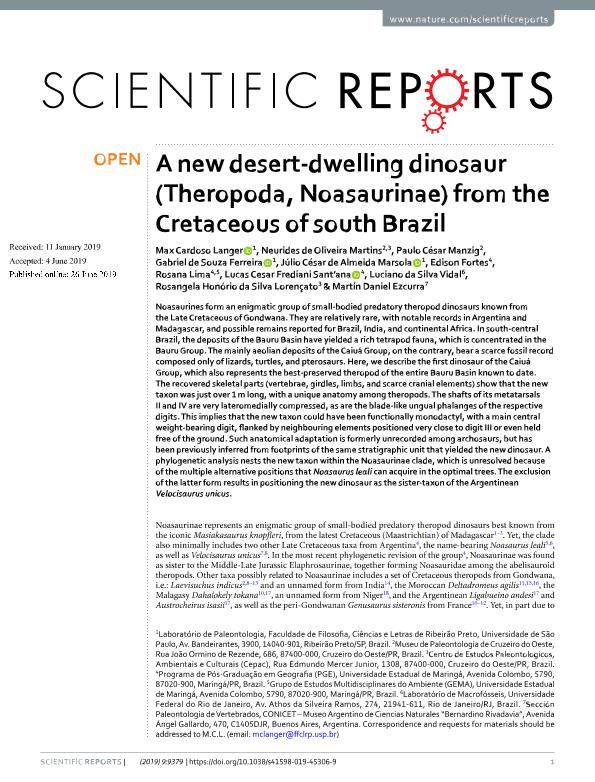Artículo
A new desert-dwelling dinosaur (Theropoda, Noasaurinae) from the Cretaceous of south Brazil
Langer, Max Cardoso; de Oliveira Martins, Neurides; Manzig, Paulo César; de Souza Ferreira, Gabriel; de Almeida Marsola, Júlio César; Fortes, Edison; Lima, Rosana; Frediani Sant'ana, Lucas Cesar; da Silva Vidal, Luciano; da Silva Lorençato, Rosangela Honório; Ezcurra, Martin Daniel

Fecha de publicación:
12/2019
Editorial:
Nature Publishing Group
Revista:
Scientific Reports
ISSN:
2045-2322
Idioma:
Inglés
Tipo de recurso:
Artículo publicado
Clasificación temática:
Resumen
Noasaurines form an enigmatic group of small-bodied predatory theropod dinosaurs known from the Late Cretaceous of Gondwana. They are relatively rare, with notable records in Argentina and Madagascar, and possible remains reported for Brazil, India, and continental Africa. In south-central Brazil, the deposits of the Bauru Basin have yielded a rich tetrapod fauna, which is concentrated in the Bauru Group. The mainly aeolian deposits of the Caiuá Group, on the contrary, bear a scarce fossil record composed only of lizards, turtles, and pterosaurs. Here, we describe the first dinosaur of the Caiuá Group, which also represents the best-preserved theropod of the entire Bauru Basin known to date. The recovered skeletal parts (vertebrae, girdles, limbs, and scarce cranial elements) show that the new taxon was just over 1 m long, with a unique anatomy among theropods. The shafts of its metatarsals II and IV are very lateromedially compressed, as are the blade-like ungual phalanges of the respective digits. This implies that the new taxon could have been functionally monodactyl, with a main central weight-bearing digit, flanked by neighbouring elements positioned very close to digit III or even held free of the ground. Such anatomical adaptation is formerly unrecorded among archosaurs, but has been previously inferred from footprints of the same stratigraphic unit that yielded the new dinosaur. A phylogenetic analysis nests the new taxon within the Noasaurinae clade, which is unresolved because of the multiple alternative positions that Noasaurus leali can acquire in the optimal trees. The exclusion of the latter form results in positioning the new dinosaur as the sister-taxon of the Argentinean Velocisaurus unicus.
Palabras clave:
Dinosauria
,
Theropoda
,
phylogeny
,
Brazil
Archivos asociados
Licencia
Identificadores
Colecciones
Articulos(MACNBR)
Articulos de MUSEO ARG.DE CS.NAT "BERNARDINO RIVADAVIA"
Articulos de MUSEO ARG.DE CS.NAT "BERNARDINO RIVADAVIA"
Citación
Langer, Max Cardoso; de Oliveira Martins, Neurides; Manzig, Paulo César; de Souza Ferreira, Gabriel; de Almeida Marsola, Júlio César; et al.; A new desert-dwelling dinosaur (Theropoda, Noasaurinae) from the Cretaceous of south Brazil; Nature Publishing Group; Scientific Reports; 9; 1; 12-2019; 1-31
Compartir
Altmétricas



